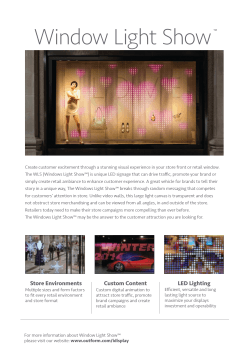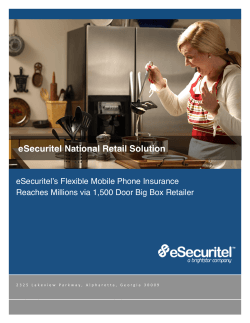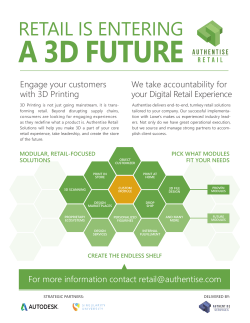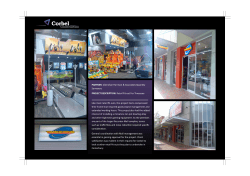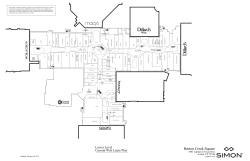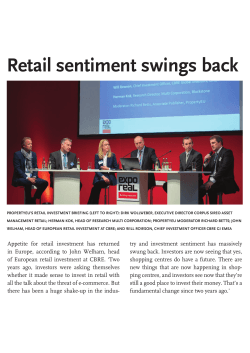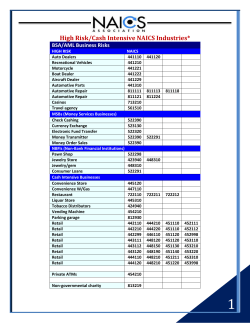
Positioning paper_US_2015
CONNECTING MEDIA, TECHNOLOGY AND BRANDS TO TOMORROW’S CONSUMER The retail industry is undergoing a dramatic shift - one punctuated by many opportunities and challenges. Technology is having a profound impact on the way consumers engage with brands... and this impact is accelerating. Seismic changes are significantly affecting brands as they move through the retail system, and raise some vitally critical questions. What’s Going On? Jose Avalos Worldwide Director, Visual Retail, Intel Corporation Barry Frey President and CEO, Digital Place-Based Advertising Association (DPAA) David Roth CEO, The Store WPP, EMEA and Asia Positioning Paper 2015 Today’s consumers are seeking closer relationships with brands, demanding more interaction, richer experiences, more personalization, customization and increased transparency. Consumers expect their relationship with brands to be relevant and 1:1. Some progress is being made by store and network operators to help brands engage with consumers but more needs to be done to make the consumer experience relevant, personal, measured and secure – and in essentially real time. In the good old days (as recently as five years ago!) the formula was simple: create a retail concept, test it out, eliminate all unnecessary costs, and then roll it out as fast and in as many locations as possible. Economics required increased volume and an increasing number of outlets. Today, scaling no longer provides the advantage it once did. You can start up an online business and use Amazon cloud at a fraction of the cost it took just a few years ago. At the same time, stores are running out of ideas. In this still traditional model, retailers spend much time looking at the back-end, supply chain and costs, rather than thinking about the front-end, experience, and how to ignite customer sales. The old retail model is broken. 1 Why is this Happening? L ook no further than the Gen Y/Millennials. There are two billion Gen Y’s globally between the ages of 18-34, and they will represent $2.5 trillion in spending by 2020. Per Jamie Gutfreund, CMO at Deep Focus, “They represent 50% of the global workforce now, but 75% in about 10 years.” I watch on TV. If I spend money on a product, I’m voting for that company, and I want to be treated the same way as if I bought stock in that company.” Led by Gen Y, consumers now expect only the smallest of differences between online and offline; the experiences should match. Consumers also want true omni-channel experiences where the customer is in the center of the engagement. This is easy to say but very difficult to deliver. Instore technology architectures are built in silos. And it’s impossible to deliver omni-channel if an organization isn’t organized as omni-channel. The path to purchase has become anything but linear. And purchase is not the end, but rather the beginning of another phase. Per Dick Cantwell, Vice President, Cisco Consulting Services, “the number one reason companies are failing or succeeding was speed of innovation. Only 24% of companies on Fortune 100 are there from 25 years ago. They used innovation to drive shareholder value.” It used to be that when you bought something, you bought it as a passive consumer. You went to a store, got the best deal you could, and then went home. Those days are gone. Per Gutfreund, “Consumers are now active participants. Not just talking about customer service, but also wanting brands to talk to them via social media. They want companies to speak with them the way they speak to investors. Social currency is about…I am what I share, I am what I buy, and I am what Positioning Paper 2015 But technology for the sake of technology is not innovation – we have to connect to the shopper. Just throwing a coffee shop into a store to “create an experience” is not innovation. A wireless provider in London put an experience store on Regent Street, opposite the Apple store. The provider had all the “things” for an experience store – experts, café, etc. Yet they created nothing that connected it all together for consumers; there was nothing to entice repeat visits. 2 So What’s the Path to Success? P ersonalization is king. Data fusion, real time decision making, knowing shoppers, creating a conversation with shoppers and being predictive have become absolutely critical. Data-driven insight aligned with the traditional and often forgotten skill of the best in breed merchant is now the differentiator. Some of this is happening already – some retailers are surrounding the consumer with sensors, RFIDs, cameras, infrared, etc.…to capture traffic intelligence in real-time. They are meshing such data with other data sources, including transactional, behavioral, environmental and back-end management systems. They are using all this as a platform to allow them to push decision-making closer to the consumer; to enable satisfying experiences that are relevant and personal; to drive operational excellence in the store; to free up labor to be more customer facing and give Positioning Paper 2015 them a better experience in ways that are meaningful to them as individuals. The gap is widening, though, between leaders and laggards. The latter are stuck in the old model of simple analytics. People consume different media at different times of the day (mobile, desktop, tablet, digital place based, television, etc) so brands and retailers need to interact with consumers across all those devices, at all times. Retailers and brands also need to be able to use data to interact with the customer of one, giving their customers meaningful and individual experiences. One of the biggest challenges facing retailers and digital out of home operators today is the fact that the existing IT infrastructure, for the most part, has been developed in-house and based on proprietary solutions. The retail IT infrastructures will need to morph again in a way that is based on standard and broad selection of offthe-shelf tools, and support the delivery of next generation experiences for the next 10-15 years. The infrastructure will need to support elongated shopping experiences, which begin before the shopper sets foot in the store and continue post-visit. It will also have to support real-time analytics enabled by in-store technologies and other types of sensors. The infrastructure will have to integrate seamlessly with every technology touch point in the store to make every experience seamless and relevant, and with the multiplicity of devices that consumers bring into the stores. 3 Who Is Leading The Way? A ll over the world, we are witnessing unprecedented innovations made possible by technology. IKEA in Japan created rooms in train cars to create uniquely comfortable experiences. In Asia, the paper menu is fast disappearing, moving to tablets and adding more focus on engagement and experience. Adidas is scaling their “Virtual Footwear Wall” in their stores, putting many of their shoes at shoppers’ fingertips in a futuristic mash-up of e-commerce and the mall. Lego has developed the Digital Box, a leading augmented reality experience. Costa Coffee, the UK’s largest coffeehouse chain and the second largest in the world, is re-inventing self-serve coffee kiosks. With a sensor that sees an approaching customer, an HD video screen that sets the mood and a coffee fragrance that is emitted from the device, they have created an intelligent coffee machine that grinds to customer preference and satisfaction. And then there’s Argos, moving from a pen/paper catalog showroom business to new experimental stores… a total digital experience. They didn’t change the core proposition, just the experience. That’s key. Digital place based advertising is being used by brands to deliver relevant, persuasive connections with consumers. Pilot TV, for example, which is Taiwan’s largest digital signage media operator, has 6,000 screens and more than four million viewers daily. Over half of those installations are audience aware, remotely managed, secure and integrated as part of a smart IT infrastructure that delivers engaging programming, targeted advertisements, real-time content customizations and relevant and personal viewing experiences. Per Mac Ma, General Manager of Pilot TV, “the investment that we have made in the IT infrastructure including intelligent screens is what’s driving our 28% annual revenue growth from media operations.” Luxottica, a leader in premium fashion, luxury and sports eyewear, with 7,000 retail stores worldwide and iconic brands such as Ray Ban, Oakley and Persol, has been making strategic investments to transform their IT infrastructure to enable them to deliver rich and relevant in-store customer experiences, which in turn help increase revenue, drive traffic and conversion, and create a unique brand experience. Per Tom Schuetz, Senior VP and CTO Americas/Asia Pacific, “the future of retail is all about the experience with the brand. Our use of in-store tablets for personalization of frames and engaging digital signage has made our instore experience engaging and consistent with the customer’s online experience. As we move to an increased segmentation/ personalization capability model through the use of CRM and analytics, the customer will be engaged both pre- and post-purchase knowing that Luxottica is caring for them, their preferences, their eye care, and providing personally relevant information and communicating directly to them when they want, and how they want”. continued Positioning Paper 2015 4 Continued from page 4 FITCH, which is a leading global retail and brand consultancy firm, with an integrated offer of strategy, design and implementation, has been at the forefront of designing the future of stores. Per Tim Greengalgh, Chairman, “We worked with Asian Paints, India’s largest commercial paint manufacturer, to change their brand perception to be seen as the home and décor experts in Asia. We created the ‘Color with Asian Paints’ experience, an inspirational and educational color experience that offers a highly personalized color solution for each and every customer. Guests interact and experience what color can do for their homes without buying a single pot of paint. Using RFID ‘color cards,’ guests collect their ideas and experiences, which are downloaded and incorporated in their own personalized take-home color magazine. On the back wall of the store, the full range of Asian Paints colors is displayed on small cubes. After guests choose their preferred combination, guests are guided by a Color Consultant to visualize their ideas in a virtual room on screen – spin the Color 3D cubes to fine tune the colors; one way to darken; the other and it lightens.” The result: the Color Store experience has fundamentally changed the brand of Asian Paints. They are now the brand and décor experts in India. Sales increased by 35% by selling lots of tins of paint in their adjacent dealer stores. Positioning Paper 2015 Adspace Digital Mall Network which has over 3600 screens in U.S malls delivers to retailers “real time advertising” using product visuals and information on the screens…like a digital catalog. The same messages are also displayed on the network’s mobile app (Clip’d) providing shoppers mall-specific product and sale information. In addition, Adspace directly feeds the retailer’s Instagram post of product or sale information also on to the mall screens. Blue Bite, the NYC based mobile solutions provider for the digital place based and retail industries, along with SMARTRAC, developer and supplier of RFID and NFC transponders and inlays, add a digital layer to everyday objects in the real-world. From embedding NFC into sneakers for one of the largest athletic shoe manufacturers, to enabling check-ins and customer loyalty at major retailers, they allow users to communicate with objects, and objects to communicate with each other. In addition to the billions of connected devices that consumers are using from smartphones to cars and tvs, the ability to enable seemingly “unconnected” objects through NFC and RFID will introduce exponentially more touchpoints into the ecosystem. This will enable consumers to have a richer experience with the objects around them as well as give brands and retailers a much more holistic view of how users are engaging with their merchandise before, during and after the sales process. 5 What’s The Bottom Line? T he bottom line is this: The future of retail and digital out of home is all about truly understanding and engaging with a rapidly changing consumer, delivering satisfying, rewarding and value-creating experiences wherever and whenever the consumer wants to buy. We need to enable infrastructure to deliver such 1:1 and seamless experiences. And we need to measure the impact more effectively and quantifiably, i.e., audience count, demographic, dwell, impact. Successful online retailers have, for some time, been investing in capabilities to understand their customers’ digital Positioning Paper 2015 journey, and in technologies for delivering easy, more personalized online experiences. Consumers now expect that the ease and personalization they experience in the online world will be translated to the physical retail environment as well. This is challenging to deliver, but it is absolutely essential in order to be relevant to consumers in the future. The pace of innovation in bricks and mortar environments will need to be as fast to execute as it is in the online world. Realistically, this can’t happen at once but key to successful step-by-step delivery will be creating the right IT base and infrastructure. This will enable and support the introduction of customer-facing technologies that deliver shopping experiences that are relevant for each and every customer; that are quick and easy to introduce and intuitively responsive to the ever-changing expectations of digital-savvy consumers. 6 To get ahead of the field: The Digital Place Based Advertising Association represents leading companies in the video everywhere ecosystem. DPAA promotes and fosters collaboration between these companies and advertisers/agencies; provides standards, best practices and industry-wide research; and promotes the effectiveness of digital place based advertising. Digital place based media is defined as networked digital video screens containing programming and advertising, reaching consumers on their daily journeys in places where they dwell. The DPAA is a Video Everywhere AssociationTM. www.videoeverywhere.com Barry Frey, President, CEO, Digital Place Based Advertising Association (DPAA) Barry.Frey@dp-aa.org Twitter: @barryfrey Intel is a world leader in computing innovation. The company designs and builds the essential technologies that serve as the foundation for the world’s computing devices. For more information on personalizing the shopping experience, visit us at www.intel.com/retailsolutions Intel Retail Solutions Division, IOT Group. Contact Jose Avalos, Worldwide Director, Visual Retail jose.a.avalos@intel.com Twitter: @Intel_Jose WPP is the world’s largest communications services group. Through its operating companies, the Group provides a comprehensive range of advertising and marketing services including extensive eCommerce, digital, retail and shopper marketing services across the globe. For more information, visit www.wpp.com The Store WPP is the WPP global retail practice. Contact David Roth, CEO, The Store WPP, EMEA & Asia david.roth@wpp.com Blog: www.davidroth.com Twitter: @davidrothlondon Positioning Paper 2015 7
© Copyright 2025
